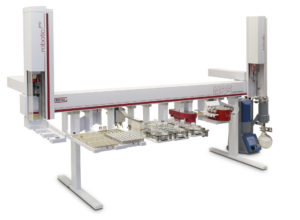Application Note ReView: AS133 – Method Development Considerations for Automated Headspace Solvent MicroExtraction (aHSME) Using a GERSTEL MultiPurpose Sampler (MPS2)
Application Note ReView: AS133 – Method Development Considerations for Automated Headspace Solvent MicroExtraction (aHSME) Using a GERSTEL MultiPurpose Sampler (MPS2)
The need for increased sensitivity and selectivity is a constant challenge facing many industries. One such technique that is becoming more popular amongst analytical scientists to overcome these challenges in a variety of sample types, particularly complex matrices, is Single Drop MicroExtraction (SDME).
SDME involves suspending a microdrop (typically 1-3µl) of solvent from the tip of a syringe in either a liquid sample, or the headspace above it. The intent is that analytes in the liquid sample or headspace migrate into the microdrop of solvent resulting in an enriched sample that can be retracted back into the syringe and injected directly onto a Gas Chromatography or Liquid Chromatography system for analysis.
Therefore, in this edition of Application Note ReView we take a look back at AS133 – Method Development Considerations for Automated Headspace Solvent MicroExtraction (aHSME) Using a GERSTEL MultiPurpose Sampler (MPS2).
This application note describes the automated Headspace Solvent Micro-Extraction (HSME) and optimisation of solvent choice and sample temperature for the analysis of common leachable chemicals in pharmaceutical products. It focusses on common extractable/leachable substances in aqueous based sample systems, and can be described as occurring over 4 stages;
1. Sample Incubation – analytes are driven into the headspace
2. Enrichment – analytes are extracted into microdrop during the exposure period
3. Solvent Recovery – the microdrop containing the analytes is retracted back into syringe
4. Injection – Direct injection onto GC System.
The analysis showed reasonable repeatability with %rsd of <18 (n=6) for the 23 tested analytes. This is cruial because sample enrichment is an important consideration when aiming to solve complex analytical challenges posed by substances leaching from materials used to manufacture, deliver or package a pharmaceutical product. For Large Volume Parenteral (LVP) pharmaceuticals, it has become increasingly more challenging to align leachable methods to the Safety Concern Threshold (SCT) and Genotoxic Impurities guidance. Furthermore, pharmaceutical formulations, due to their increasing complexity, require selective extraction techniques that pre-clean the sample prior to analysis.
As such, the additional sensitivity (4ng per ml of sample) and selectivity that can be gained from HSME makes this an attractive choice for analysts developing quantitative leachable methods for complex biopharmaceutical and parenteral applications.
Download the full Application Note
**********************
Anatune Application Notes:
Anatune (and our partners) regularly produce Application Notes. These cover a wide and diverse range of methods, techniques, applications, and related chromatography technology. Our Application Notes provide detailed technical information, unique applications insight and method development & validation, as well as systems configuration innovations to ensure readers can further their knowledge in an engaging way. For many years, Anatune’s Application Notes have helped and supported analytical chemists in the fields of Gas Chromatography – GC, Liquid Chromatography – LC, and Mass Spectrometry – MS achieve to develop analytical solutions. Visit our Applications Note page to search for the insight you need in the following categories: Matrix, Technique, Analyte, Instruments, Product, Industry. Or alternatively, CONTACT US for more information or to put forward an Application Note subject and our Applications Team will be happy to support you in any way they can.


